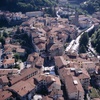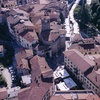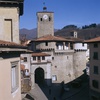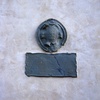Castle of Castelnuovo di Garfagnana
The castle of Castelnuovo Garfagnana, surrounded by water to the east, south and north consists of a wall that encloses the settlement, vaguely trapezoidal in shape, and the Ariostesca fort, both built around the 14th century. Located in the valley near the confluence of the stream Turrite Secca and the river Serchio, Castelnuovo acted as a barricade of the road that, through the high valleys of the Garfagnana, led to the Lunigiana and Ferrarese regions, retracing the consular paths of Roman times.
Large stretches of the walls are well-preserved, especially to the north. There are two angular towers of semi-circular form. The first is located near the town gate, the second about halfway along the walls where they suddenly began to lose linearity.
Fort Ariostesca, however, has undergone considerable restoration, especially after the Second World War, when the town was hit by aerial bombing. The semi-circular tower that opens on the south side is a powerful structure grafted into the city walls, similar to the style of construction of the other towers of the castle, cylinder based and without scarping.
Near the fort is the Cathedral of Saints Peter and Paul in a Renaissance style. Inside you can admire a terracotta attributed to Andrea della Robbia, an altarpiece of San Giuseppe, a wooden crucifix from the 15th century known as the Black Christ and a painting of the Madonna with Saints Andrew and James by Giovanni Antonio Sogliani.
Historical notes
Originally held by the Bishop of Lucca, in 997, the castle was partly passed over to the nobles of Cella Baroti. Under the Ronaldinghi and Suffredinghi families, the defences of Castrum Novum were enhanced to support the resistance of the nobles of the Garfagnana and Versilia regions against the armies of the City of Lucca during the 12th century.
Under the rule of Castruccio Castracani, the centre was equipped with a surrounding wall and an important bridge over the Serchio, named after Saint Lucia, through which it was possible to reach Pieve Fosciana and the Radici pass. Invaded by the Captain Alderigo Antelminelli in 1370 and possessed by him for a short time, Castelnuovo was returned to the Republic of Lucca the following year and in 1376 was mentioned in the Golden Bull among the most important military constructions of the Garfagnana region. The strategic importance of this site was recognised by Paolo Guinigi, who included it among the border fortresses that had to be kept perpetually ready to defend themselves. In 1430, when the power of the Lord of Lucca sharply declined, fearing the incursions of armed Florentines, Castelnuovo was surrendered to the hands of Niccolò of Este.
Many fortified outstations supported this castle, first of all the town of Monti, demolished during the 16th century to make way for the monumental fort of Mont'Alfonso, but also others such as Sassi, Montealtissimo and Palleroso.












